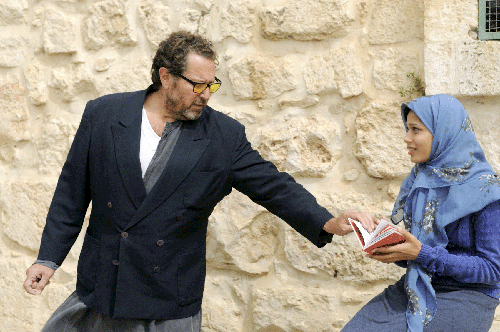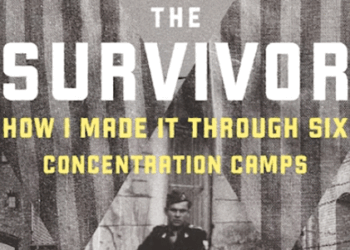Famous artist and director contends that film will advance dialogue about Israel-Palestine, but he’s wrong
By RACHEL SHTEIR
NEW YORK (Tablet) — “The movie they tried to stop is coming to New York,” read an ad for Julian Schnabel’s Miral in the March 20 New York Times. Based on a memoir by Rula Jebreal, the gorgeous 37-year-old Palestinian journalist who is also the controversial artist’s current romantic partner, the film traces the stories of four Palestinian women from 1948 to the Oslo Accords of the early 1990s. But it is hardly as daring as the ad describes.
The “they” here appears to be the Anti-Defamation League, the American Jewish Committee, and others who protested Miral’s March 14 premiere at the United Nations General Assembly. The AJC released a statement complaining that the film “portrays Israel in a negative light” and fails to provide context for the Israeli brutality shown.
‘Miral’ opens April 1 at Lagoon Cinema
Schnabel has responded to such allegations by saying it is not the responsibility of the artist to portray both sides. And here he is right. A film based on a memoir — even a political one — is not journalism. But Schnabel has also said that Miral will advance the conversation about Israel, will make American Jews listen to Palestinians, but here he is wrong.
 Director Julian Schnabel and Freida Pinto, who plays the title character in the film ‘Miral.’ (Photo: Jose Haro / The Weinstein Company)
Director Julian Schnabel and Freida Pinto, who plays the title character in the film ‘Miral.’ (Photo: Jose Haro / The Weinstein Company)
Miral is ultimately neither what its defenders claim nor what its detractors allege. The movie offers a few stunning glimpses into its heroines’ interior lives, but as a defense of the Palestinian cause — as an argument or even a plea — it fails utterly.
The match of artist and subject is seriously off kilter. What Schnabel’s previous films do best are present luminous, pictorial fragments — snapshots into how a suffering person sees. These humane films have shown the conflict between the artist’s subjective point of view and everyday brutal reality, sometimes drawing from Greek tragedy, sometimes from opera and sometimes from abstract expressionism.
Take The Diving Bell and the Butterfly, which is seen entirely through the eyes of Jean-Dominique Bauby, the newly paralyzed French editor of Elle magazine. The audience understands the world in half blinks, spasms and tics, as Bauby now does. Here Schnabel manages to make the familiar strange.
All of Schnabel’s previous films succeeded to the extent that they did because they harness highly subjective moments of suffering to one character, who in turn drives the story. In Miral, the suffering is spread among four characters in four different eras, and none is highly individuated.
And none of them are artists. As filmic subjects, Schnabel is mostly drawn to men driven to make art as a way of speaking. Bauby, the magazine editor, must relearn to see and talk as best he can; Basquiat, the outsider artist, creates paintings suggesting an authentic imagination that the art world glitterati envies and ultimately tries to destroy; Reinaldo Arenas, a gay Cuban poet who grew up in the Amazon, uses language to chisel away at a socialist world hostile to his sexual identity.
Although Schnabel wants to cast the Palestinian women in Miral in the same romantic light, the women — and it is important that they are women, since his earlier films have all focused on tragic men — are not artists and thus are not compelling as heroines. Also, while Schnabel’s men meet the fate of all romantic heroes — death — Miral ends with flight and the prospect of redemption. In the language of pop psychology, she empowers herself. While this may make a good segment on Oprah, it doesn’t make for a good movie.
Miral’s best moments show how the besieged Palestinian quartet sees and how they protect themselves from seeing the terrible wrongs committed against them. At these moments, it seemed to me that Schnabel was aiming to treat the women’s stories as though they were pieces of Moroccan zellij, the mosaic tilework that forms abstract patterns on the walls of mosques and other buildings in the Maghreb; but while those tiles are patterned to suggest some greater meaning, Miral is not.
A related problem is casting. While Schnabel’s previous films were brilliantly cast — Jeffrey Wright as Basquiat and Javier Bardem as Reinaldo Arenas were sublime — here he has stumbled. I’m not talking about choosing Freida Pinto as Miral instead of a Palestinian actress, which some critics have attacked him for. No, Schnabel’s sin here comes in mixing international stars that support the Palestinian cause with Arab actors. No sooner does Miral begin than Vanessa Redgrave and Willem Dafoe pop into the frame in cameo roles as American supporters of Hind Husseini, the Arab Mother Teresa. They dance around a Christmas tree, celebrating the founding of an orphanage. Redgrave, who is wearing a wreath on her head, looks particularly smug, and thankfully she quickly disappears.
Schnabel jumps quickly from the holiday party to archival footage of the bombing of Palestinian villages in 1948 to Husseini’s efforts to rescue children. He has defended this jerky approach — some critics have called it episodic — to his subject by saying “the fragment embodies the whole.” But using fragments cannot cover up a real problem with the story: It is extremely difficult to sustain interest in a saint, Arab or otherwise.
The film drags as Husseini struggles to keep the orphanage alive and as Schnabel shows us archival footage from the Six Day War. There is a flash of intrigue when Willem Dafoe reappears and hints at what might have been.
“What you’re doing is incredible,” Defoe says, smiling as they walk through the hills.
“This was a village,” Husseini says.
Instead of kissing, it’s back to Dafoe’s wooden dialogue: “Keep me informed.” He exits.
It is not until Miral’s mother, Nadia (Yasmine al Massri), appears that Schnabel finds the movie’s first arresting image: a metal pole moving up and down in the middle of the frame. It is a classic, abstract Schabelesque moment. It is also a sleight of hand. The pole is part of an iron bed that Nadia sees as she is being raped as a young girl.
From here, Schnabel leaps forward to grown-up Nadia’s undulating belly as she dances in a sleazy night club. The lushness of her body and the shimmering gold coins on her costume contrast with the veil covering her face.
After Nadia winds up in jail, she meets Miral’s third heroine, Fatima (Ruba Bial), a nurse who plants a bomb in a movie theater during Roman Polanski’s Repulsion. This scene has both the best wildness that Schnabel is capable of and shows his somewhat surprising sensitivity to comedy.
“It’s OK, I haven’t seen it,” Fatima says when the ticket booth guy asks her why she is late.
While Catherine Deneuve is being raped onscreen, Fatima tucks a bomb under the seat. The camera zips frantically from one face to another in the audience. Later you learn, almost as an afterthought, that the bomb didn’t go off.
Another evocative moment comes when Nadia, an alcoholic, drowns herself and Schnabel gives us the sound of the sea as it roars up around her.
When we finally meet Nadia’s daughter, the film’s title character, it is 1987, the first intifada is underway, and Miral is 16. Along with some girls who are students at the orphanage, she goes to a refugee camp to teach grammar to the stone-throwing boys.
In general, the landscape is more stirring than the politics. Husseini and Miral argue about one-state and two-state solutions as if they were reading from position papers at a Washington think tank.
And the moments where the movie eavesdrops on what Palestinians think about the Jewish settlers are disappointingly predictable: “They think… they have more rights than any Palestinian.”
Some have argued that the scene when the police torture Miral unfairly shows only one side of the conflict. This misses the point. The most striking moments in this sequence, as usual, are not the ones that are supposed to have a political punch — Miral raising her shirt in court to show the judge the welts on her back. They are when she is recovering afterward, lying in bed, watching the steamers drift by through her window, looking like nothing as much as boats in a Renoir landscape.
At the time of the Oslo Accords, Miral, who has decided she wants to be a journalist, leaves Israel. The final shots, of Husseini’s funeral to a Tom Waits soundtrack, end the film on an irrelevant note, as the movie has not convinced the audience of her importance.
It wasn’t an ending that shed any light on street-side bombs, Israeli retaliations or the settlers slaughtered earlier this month. The only thing the film convinced me of is that Schnabel should go back to painting, which — as it happens — is what he has said he is going to do.
***
This article was originally posted on Tabletmag.com, a new read on Jewish life.










 Director Julian Schnabel and Freida Pinto, who plays the title character in the film ‘Miral.’ (Photo: Jose Haro / The Weinstein Company)
Director Julian Schnabel and Freida Pinto, who plays the title character in the film ‘Miral.’ (Photo: Jose Haro / The Weinstein Company)









